Mineralogy, Geochemistry and Fluid Inclusion Data from the Tumanpınarı Volcanic Rock-Hosted Fe-Mn-Ba Deposit, Balıkesir-Dursunbey, Turkey
Abstract
:1. Introduction
2. Geology
3. Methodology
4. Results
4.1. Hydrothermal Alteration
4.2. Ore Geology
4.3. Geochemistry
4.4. Fluid Inclusion
4.4.1. Petrography
4.4.2. Microthermometric Results
4.5. Sulphur Isotopic Composition
5. Discussion
5.1. Characterization of Hydrothermal Fluids
5.2. Source of Sulfur and Metals
5.3. Temperature–Depth Relationship
5.4. Ore Deposition
5.5. Role of the Structural Factors and Age of Ore Deposition
5.6. Ore Genesis Model
6. Conclusions
Author Contributions
Conflicts of Interest
References
- Örgün, Y.; Gültekin, A.H.; Onal, A. Geology, mineralogy and fluid inclusion data from the Arapuçan Pb-Zn-Cu-Ag deposit, Çanakkale, Turkey. J. Asian Earth Sci. 2005, 25, 629–642. [Google Scholar] [CrossRef]
- Bingöl, E. Contributions a L’etude Geologique de la Partie Centraleet Sud-East du Massif Kazdağ (Turquie). Ph.D. Thesis, Universite de Nancy, Nancy, France, 1968. [Google Scholar]
- Krushensky, R.D.; Akçay, Y.; Karaege, E. Geology of an Area East of Edremit, Biga Peninsula, NW Turkey; U.S. Geological Survey: Reston, VA, USA, 1971; p. 132.
- Yücelay, M.A. Geological study of Karaköy-Arapuçan dere Pb-Zn-Cu mineralization, Çanakkale-Yenice. Econ. Geol. 1971, 82, 1575–1591. [Google Scholar]
- Aydın, E.; Öztunalı, O. Occurrence conditions of the Pb-Zn mineralization of the Biga Peninsula. Yerbilimleri 1981, 1, 10–20. [Google Scholar]
- Ağdemir, N.; Kırıkoğlu, M.S.; Lehmann, B.; Tietze, J. Petrology and alteration geochemistry of the Epithermal Balya Pb-Zn-Ag deposits NW Turkey. Miner. Depos. 1994, 29, 366–371. [Google Scholar] [CrossRef]
- Yılmaz, Y. Comparison of young volcanic associations of western and eastern Anatolia formed under a compressional regime: A review. J. Volcan. Geotherm. Res. 1990, 44, 69–87. [Google Scholar] [CrossRef]
- Ercan, T.; Satır, M.; Kreuzer, H.; Türkecan, A.; Günay, E.; Çevikbaş, A.; Ateş, M.; Can, B. Batı Anadolu Senozoyik volkanitlerine ait yeni kimyasal, izotopik ve radyometrik verilerin yorumu. Turk. Jeoloji Bülteni 1985, 28, 121–136. (In Turkish) [Google Scholar]
- Gültekin, A.H.; Örgün, Y. Geochemisrty of Andesite-hosted, vein-type Mn-Ba Mineralizations, Bigadiç, Balıkesir, Turkey. Prog. Min. Oilfield Chem. 1999, 1, 239–248. [Google Scholar]
- Gültekin, A.H.; Örgün, Y.; Yavuz, F. Tumanpınarı (Balıkesir-Dursunbey) Fe-Mn cevherleşmesinin jeolojik, mineralojij ve jeokimyasal özellikleri. Turk. Jeoloji Bülteni 1998, 41, 13–28. (In Turkish) [Google Scholar]
- Yigit, O. A prospective sector in the Tethyan Metallogenic Belt: Geology and geochronology of mineral deposits in the Biga Peninsula, NW Turkey. Ore Geol. Rev. 2012, 46, 118–148. [Google Scholar] [CrossRef]
- Okay, I.A. Tavşanlı zonu: Anatolid-Torid Bloku’nun dalma-batmaya uğramış kuzey ucu. MTA Derg. 2011, 142, 195–228. (In Turkish) [Google Scholar]
- Ketin, I. Batı Anadolunun Tectonik Birlikleri. MTA Derg. 1966, 66, 20–34. [Google Scholar]
- Bingöl, E. Batı Anadolunun Jeotektonik evrimi. MTA Derg. 1976, 86, 14–43. [Google Scholar]
- Manav, H.; Gültekin, A.H.; Uz, B. Geochemical evidence for the tectonic setting of the Harmancık ophiolites, NW Turkey. J. Asian Earth Sci. 2002, 24, 1–9. [Google Scholar] [CrossRef]
- Prelevic, D.M.; Akal, C. Tracking post-collisional dynamics of orogenic mantle in southwestern Anatolia using ultrapotassic mafic rocks as geochemical proxies. In Proceedings of the International Earth Science Colloquim on the Aegean Region, İzmir, Turkey, 1–5 October 2012.
- Harris, N.B.W.; Kelley, S.; Okay, A.I. Post-collision magmatism and tectonics in northwest Anatolia. Cont. Min. Petrol. 1994, 117, 214–252. [Google Scholar] [CrossRef]
- Triantaphyllou, M.; Papanikolaou, D. Tectonic change from compression to extension at ±30 Ma in the Thraki Basin (Greece-Turkey). In Proceedings of the International Earth Science Colloquim on the Aegean Region, İzmir, Turkey, 1–5 October 2012.
- Erentöz, C. 1/500000 Ölçekli Türkiye Jeoloji Haritası; MTA Genel Müdürlüğü: Ankara, Turkey, 1975. [Google Scholar]
- Roedder, E. Technique for the extraction and partial chemical analysis of fluid-filled inclusions from minerals. Econ. Geol. 1958, 53, 235–269. [Google Scholar] [CrossRef]
- Roedder, E. Compostion of Fluid Inclusion; U.S. Geological Survey: Reston, VA, USA, 1972; p. 164.
- Roedder, E. Fluid Inclusions; Mineralogical Society of America: Chantilly, VA, USA, 1984; p. 644. [Google Scholar]
- Balci, N.; Shanks, W.C.; Mayer, B.; Mandernack, K.W. Oxygen and sulfur isotope systematics of sulfate produced during bacterial and abiotic oxidation of pyrite. Geochim. Cosmochim. Acta 2007, 71, 3796–3811. [Google Scholar] [CrossRef]
- Schroll, E.; Rantitsch, G. Sulphur isotope patterns from the Bleiberg deposit (Eastern Alps) and their implications for genetically affiliated lead–zinc deposits. Mineral. Petrol. 2005, 84, 1–18. [Google Scholar] [CrossRef]
- Winchester, J.A.; Floyd, P.A. Geochemical classification of different magma series and their differentiation products using immobile elements. Chem. Geol. 1977, 20, 325–343. [Google Scholar] [CrossRef]
- Le Maitre, R.W. A Classification of Igneous Rocks and Glossary of Terms; Blackwell: Oxford, UK, 1989; p. 193. [Google Scholar]
- Leal, P.R.; Correa, M.J.; Ametrano, S.J.; Etcheverry, R.O.; de Brodtkorb, M.K. The manganese deposits of the Pampean Ranges, Arjantine. Can. Mineral. 2008, 46, 1215–1233. [Google Scholar] [CrossRef]
- Lykasis, N.; Killias, S.P. Epithermal manganese mineralization, Kimolos Island, South Aegean volcanic arc, Greece. In Bulletin of the Geological Society of Greece, Proceedings of the 12th International Congress, Patras, Greece, 25 June–1 July 2012; pp. 2646–2656.
- Haas, J.L. An equation for the density of vapour-satured NaCl-H2O solutions from 75–325 °C. Am. J. Sci. 1970, 29, 489–493. [Google Scholar] [CrossRef]
- Akande, S.O.; Horn, E.E.; Reutel, C. Mineralogy, fluid inclusion and genesis of the Arufu and Akwana Pb-Zn-F mineralization, middle Benue Trough, Nigeria. J. Afr. Earth Sci. 1988, 7, 167–180. [Google Scholar] [CrossRef]
- Asi, S.M.; Jafari, M.; Sahamiyeh, R.Z.; Shahrokhi, V. Geology, geochemistry, sulfur isotope composition, and fluid inclusion data of Farsesh barite deposit, Lorestan Province. Iran. Arab. J. Geosci. 2015, 8, 7125–7139. [Google Scholar]
- Zou, H.; Zhang, S.; Chen, A.; Fang, Y.; Zeng, Z. Hydrothermal fluid source of the Fengjia Barite-Fluorite Deposit in southeast Sichuan, China: Evidence from Fluid inclusions and hydrogen and oxygen isotopes. Resour. Geol. 2016, 66, 24–36. [Google Scholar] [CrossRef]
- Nash, J.T. Fluid Inclusion Studies of Some Gold Deposits in Nevada; U.S. Geological Survey: Reston, VA, USA, 1972.
- Sawkins, F.J. Metal Deposits in Relation to Plate Tectonics; Springer: New York, NY, USA, 1990; p. 461. [Google Scholar]
- Gültekin, A.H.; Örgün, Y.; Suner, F. Geology, mineralogy and fluid inclusion data of the Kizilcaören Fluorite-barite-REE deposit, Eskişehir, Turkey. J. Asian Earth Sci. 2003, 21, 365–376. [Google Scholar] [CrossRef]
- Olade, M.A.; Morton, D. Origin of lead-zinc mineralization in the southern Benue Trough, Nigeria-Fluid inclusion and trace element studies. Miner. Depos. 1985, 20, 76–80. [Google Scholar] [CrossRef]
- Norman, I.D.; Bozrafshan, K.; Eggleston, T.L. Mineralization of the Luis Lopes epithermal manganese deposits in light of flud inclusion and geologic studies. In New Mexico Geological Society Guide Book, Proceedings of New Mexico Geological Society Thirty-Fourth Annual Field Conference, Socorro, NM, USA, 13–15 October 1983; pp. 247–251.
- Hedenquist, J.W.; Henley, R.W. The importance of CO2 on freezing point measurements of fluid inclusions: Evidence from active geothermal systems and implications for epithermal ore deposition. Econ. Geol. 1985, 80, 1379–1406. [Google Scholar] [CrossRef]
- Arribas, A.J.R.; Cunningham, C.G.; Rytuba, J.J.; Rye, R.O.; Kelly, W.C.; Podwysocki, M.H.; McKee, E.H.; Tosdal, R.M. Geology, geochronology, fluid inclusions and isotope geochemistry of the Rodalquilar Au alunite deposits, Spain. Econ. Geol. 1995, 90, 795–822. [Google Scholar] [CrossRef]
- Bozkaya, G.; Gökçe, A. Lead and sulfur isotope studies of the Koru (Çanakkale, Turkey) lead-zinc deposits. Turk. J. Earth Sci. 2009, 48, 127–137. [Google Scholar]
- Lindgren, W. Mineral Deposits; McGraw-Hill: New York, NY, USA, 1933. [Google Scholar]
- Cooke, D.R.; McPhail, D.C.; Bloom, M.S. Epithermal gold mineralization, Acupan, Baguio District, Philippines: Geology, mineralization, alteration, and the thermochemical environment of ore deposition. Econ. Geol. 1996, 91, 243–272. [Google Scholar] [CrossRef]
- Ohmoto, H.; Goldhaber, M.B. Sulfur and carbon isotopes. In Geochemistry of Hydrothermal Ore Deposits, 3rd ed.; Barnes, H.L., Ed.; Wiley: New York, NY, USA, 1977; pp. 517–611. [Google Scholar]
- Rao, D.V.S.; Naqvi, S.M. Geological setting, mineralogy, geochemistry and genesis of the Middle Archaean Kalyadi copper deposit, western Dharwar craton, Southern India. Miner. Depos. 1977, 32, 230–242. [Google Scholar] [CrossRef]
- Bralia, A.; Sabatin, G.F.; Troja, F. A revaluation of the Co/Ni ratio in pyrites as a geochemical tool in ore genesis problems. Miner. Depos. 1979, 14, 353–374. [Google Scholar] [CrossRef]
- Bajvan, Z.; Seccombe, P.K.; Ofter, R. Trace element distribution, Co:Ni ratios and genesis of the Bıg Cadia iron-copper depsits, New South Wales, Australia. Miner. Depos. 1987, 22, 292–300. [Google Scholar]
- Haas, J.L. The effect of salinity on the maximum thermal gradient of a hydrothermal system at hydrostatic pressure. Econ. Geol. 1971, 66, 940–946. [Google Scholar] [CrossRef]
- Bowers, T.; Helgeson, H. Calculation of the thermodynamic and geochemical consequences of nonideal mixing in the system H2O-CO2-NaCl on phase relations in geological systems: Equations of stable H2O-CO2-NaCl fluids at high pressures and temperatures. Geochim. Cosmochim. Acta 1983, 47, 1247–1275. [Google Scholar] [CrossRef]
- Yavuz, F.; Gültekin, A.H.; Örgün, Y.; Çelik, N.; Karakaya, M.Ç.; Şaşmaz, A. Mineral chemistry of barium-and titanium-bearing biotites in calc-alkaline volcanic rocks from the Mezitler area (Balıkesir Dursunbey), Western Turkey. Geochem. J. 2002, 36, 563–580. [Google Scholar] [CrossRef]
- Nielsen, H. Sulfur Isotopes in Isotope Geology; Jager, E., Hunziker, J.C., Eds.; Springer: New York, NY, USA, 1979; pp. 283–312. [Google Scholar]
- Stumbfl, E.F.; Kırıkoglu, M.S. Fluorite-barite-rare earths deposits at Kızılcaören, Turkey. Mitt. Österr. Geol. Ges. 1985, 78, 193–200. [Google Scholar]
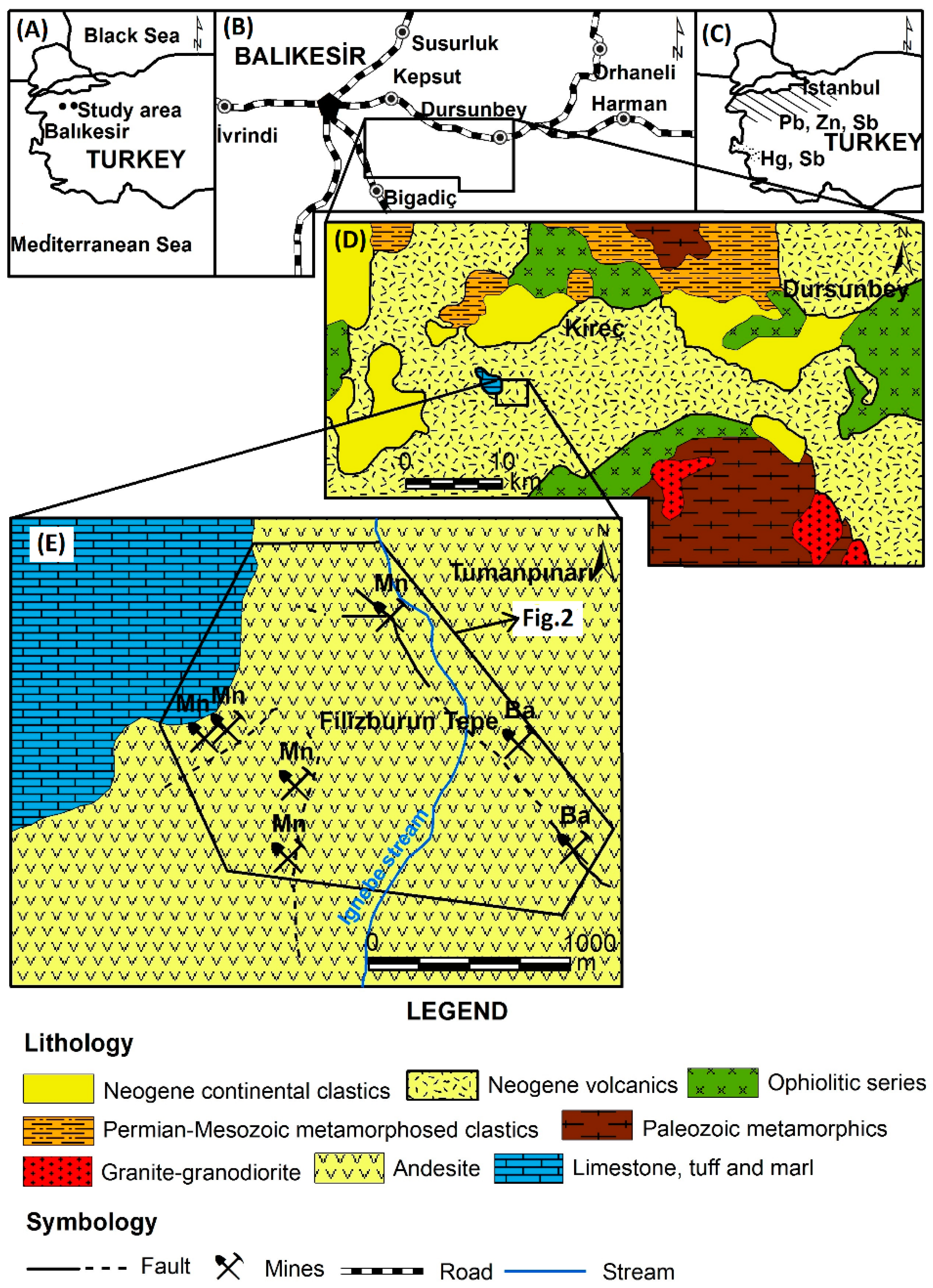
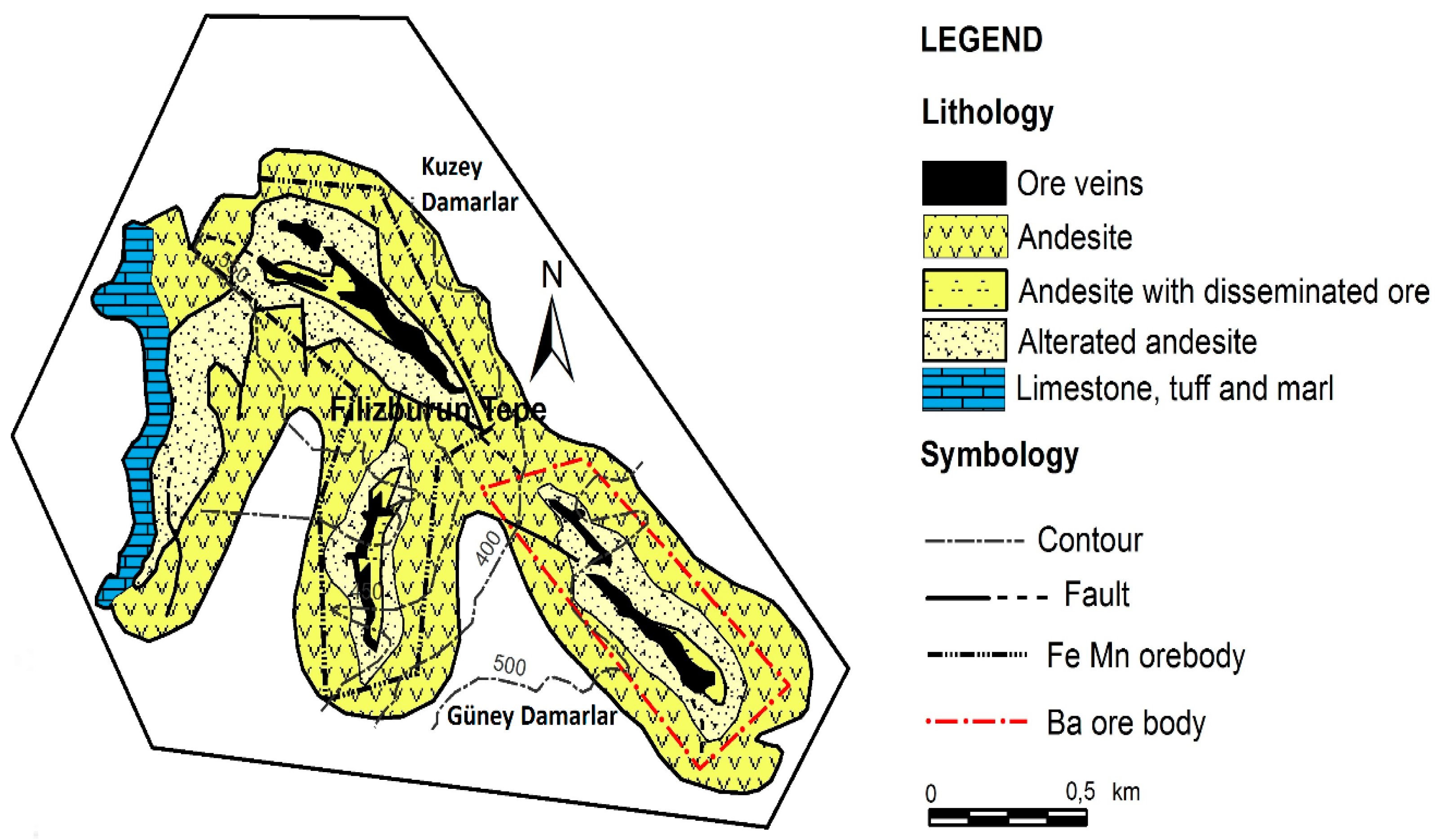
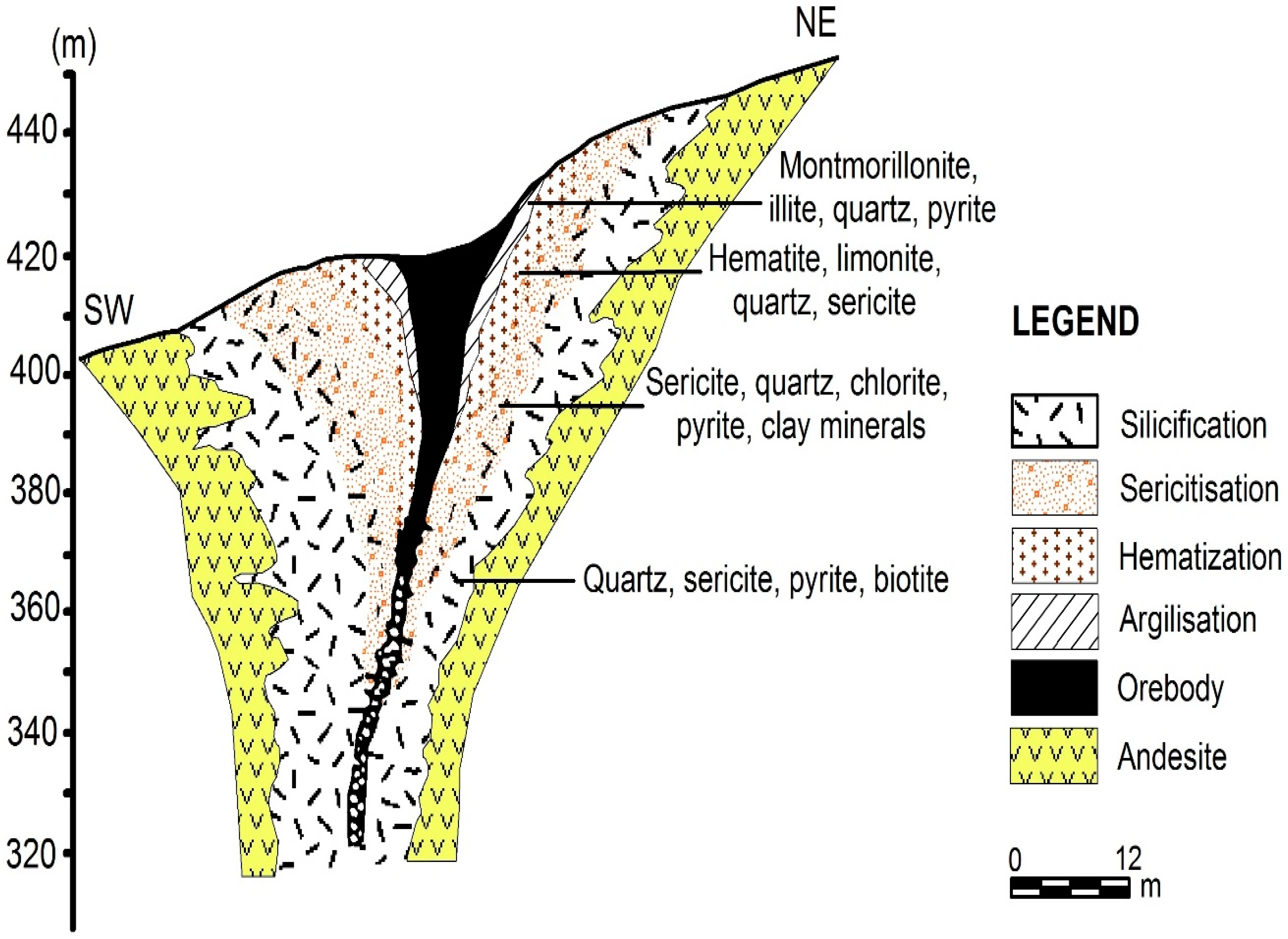

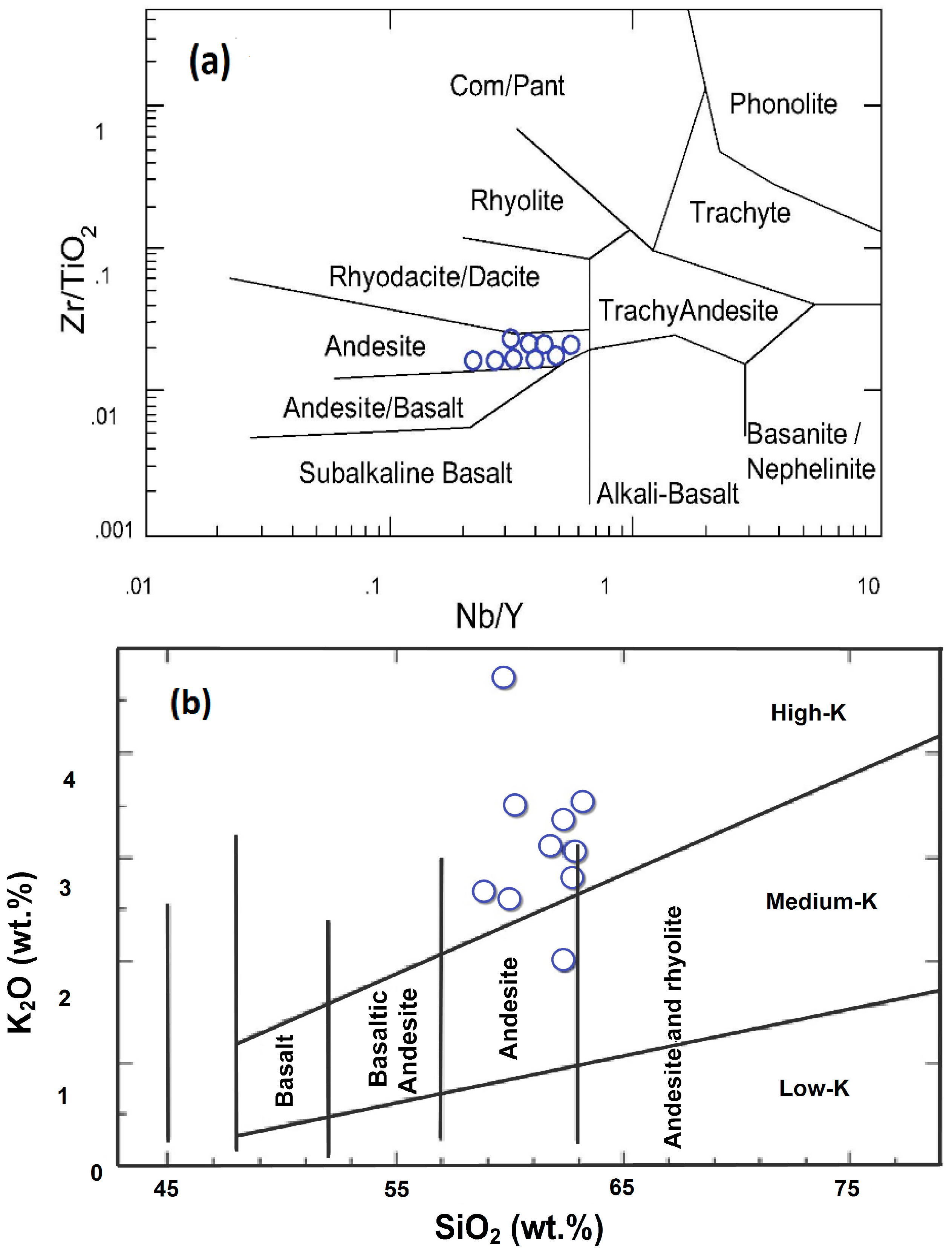

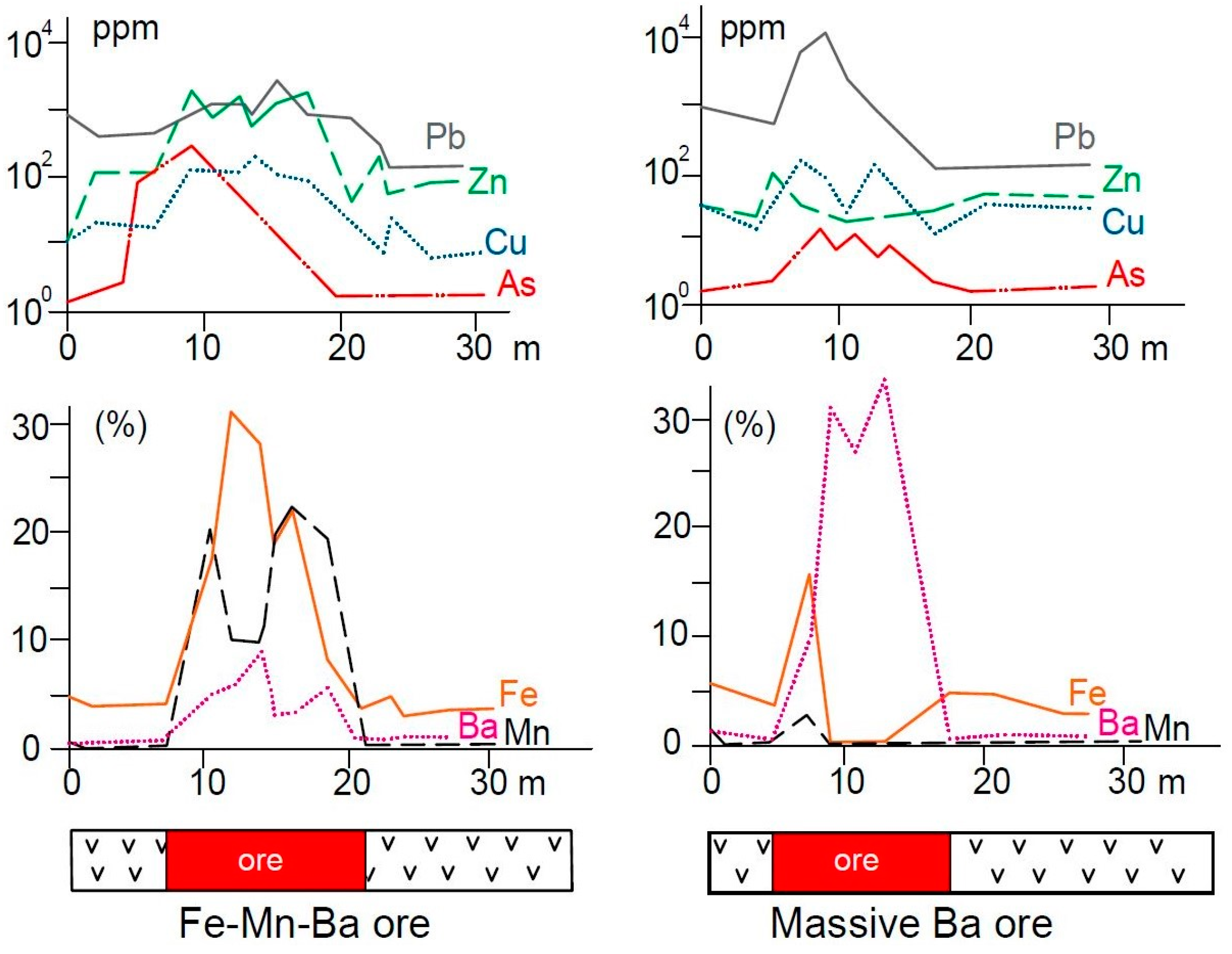
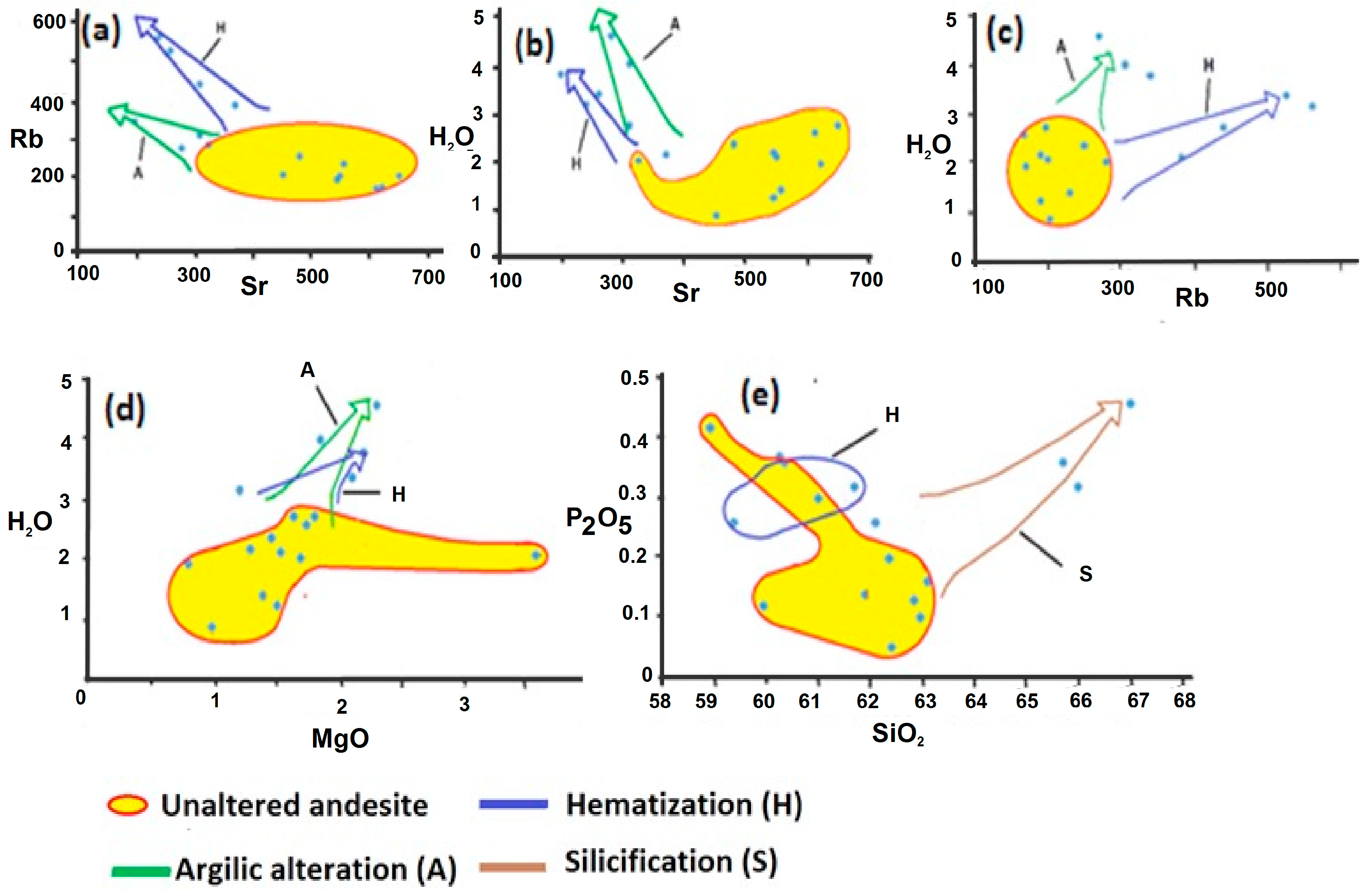
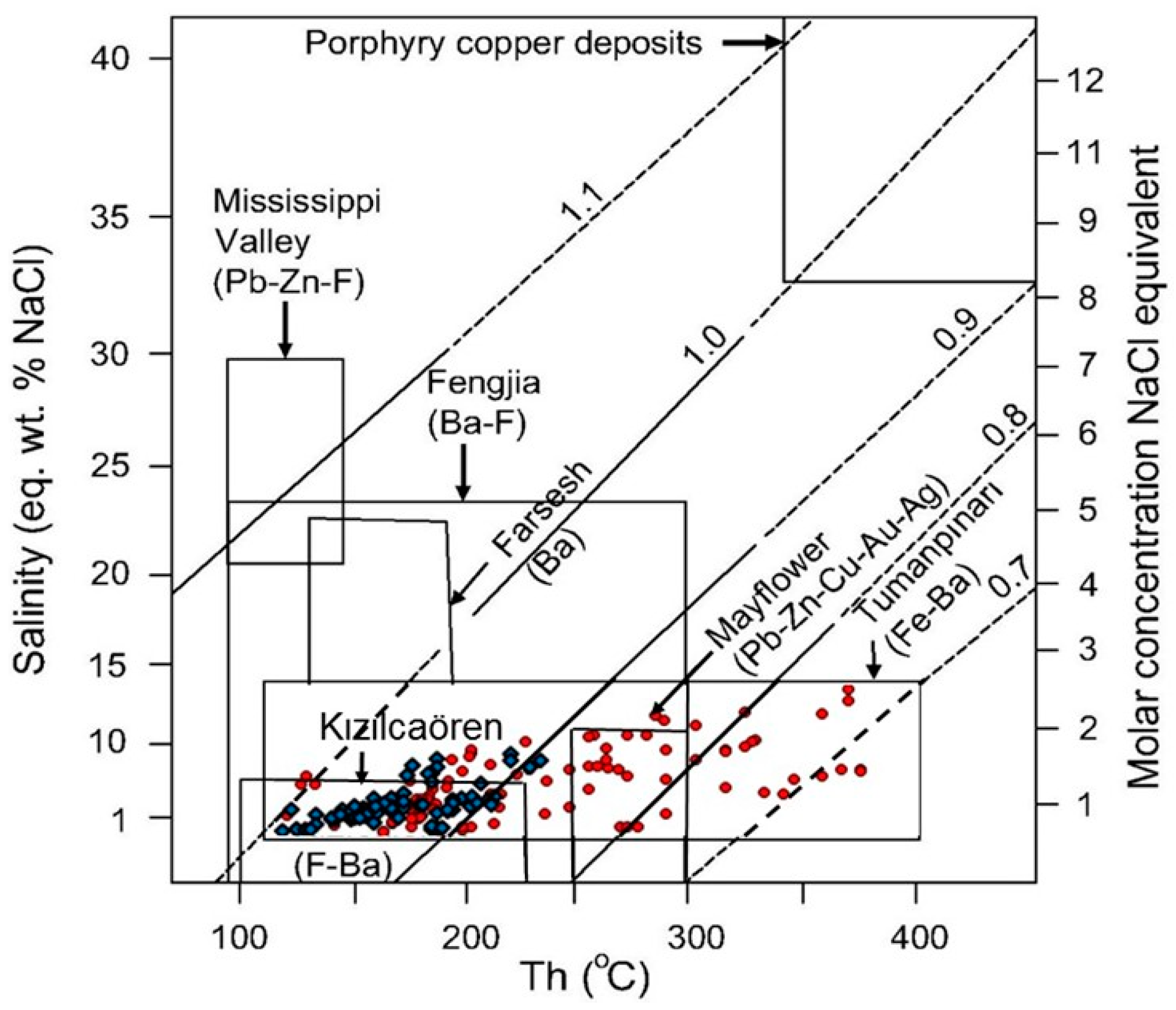
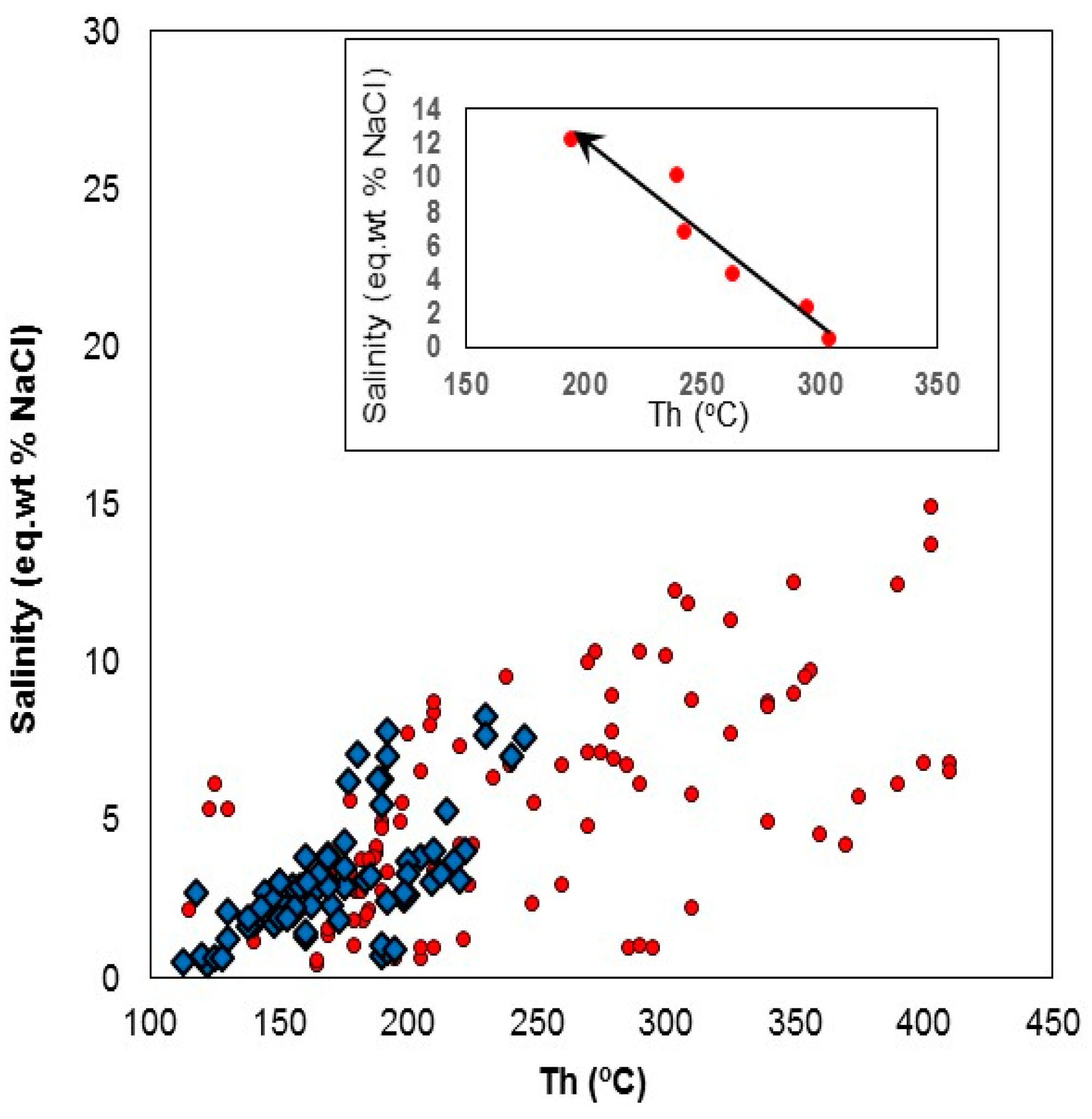
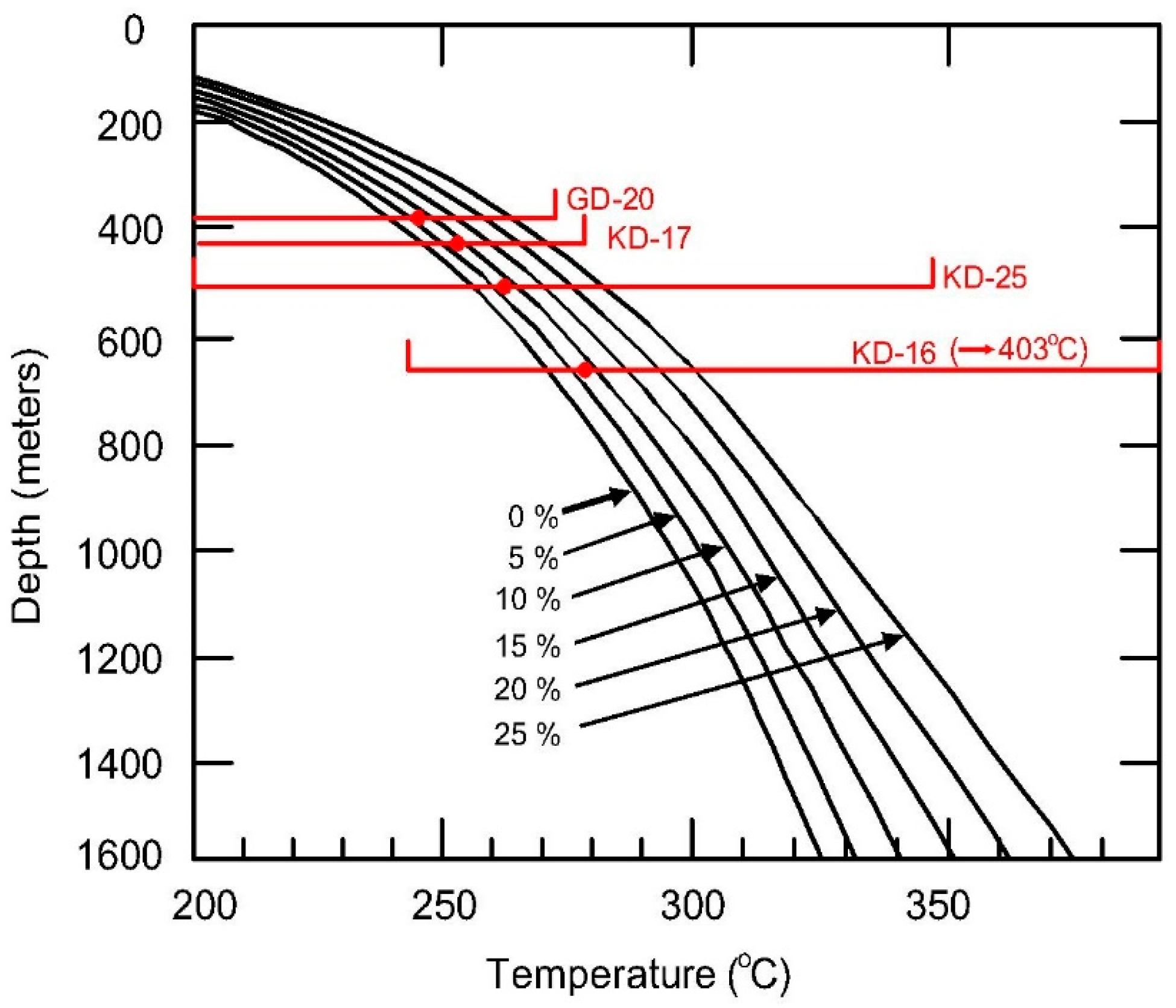

| Alterations | Minerals | Abundance of Minerals | Remark | ||
|---|---|---|---|---|---|
| Common | Moderately Abundant to Rare | Trace | |||
| Silicic | Quartz | + | Most common alteration types in the andesite as mostly massive and vuggy silica bodies. Presence of different grain-sized quartz. Local hydrothermal quartz crystals in fractures and pores of residual silica. Massive silica consists of microcrystalline quartz derived from the recrystallization of amorphous silica. Occurrence of rutile related to decomposed biotites. | ||
| Sericite | + | + | |||
| Pyrite | + | ||||
| Biotite | + | ||||
| Chlorite | |||||
| Sericitization | Sericite | + | It is seen as a low-intensity alteration haloes surrounding the veins. With progressive alteration, the plagioclase becomes riddled with flakes of fine-grained sericite. Grading outward into silicic alteration. | ||
| Quartz | + | ||||
| Clay minerals | + | ||||
| (Kaolinite) | |||||
| Chlorite | + | ||||
| Pyrite | + | ||||
| Hematisation | Hematite | + | The slight reddening of plagioclase and transformation of biotite to chlorite is common. It is seen as haloes surrounding the veins. Some of the hematite is related to ore-stage and shows a textural relationship with magnetite and euhedral quartz crystals. | ||
| Limonite | + | ||||
| Quartz | + | ||||
| Sericite | + | ||||
| Biotite | + | ||||
| Argillic | Montmorillonite | + | It is seen as a moderate-intensity alteration zone surrounding the massive silica and ore bodies, but locally overprinting the sericitization and hematisation. It is mostly seen as an outer alteration zone and mainly characterized by the complete replacement of plagioclase by clay minerals. | ||
| (Illite) | + | ||||
| Quartz | + | ||||
| Pyrite | + | ||||
| Sericite | + | ||||
| Calcite | + | ||||
| Content | 1 | 2 | 3 | 4 | 5 | 6 | 7 | 8 | 9 | 10 |
|---|---|---|---|---|---|---|---|---|---|---|
| SiO2 | 62.85 | 62.41 | 62.96 | 59.95 | 63.10 | 60.36 | 61.91 | 58.91 | 62.36 | 59.37 |
| TiO2 | 0.60 | 0.74 | 0.85 | 0.62 | 0.65 | 0.84 | 0.70 | 0.63 | 0.49 | 0.73 |
| Al2O3 | 13.61 | 16.63 | 15.92 | 18.13 | 17.18 | 16.52 | 16.09 | 14.87 | 17.51 | 15.69 |
| Fe2O3 | 6.81 | 5.88 | 7.98 | 4.53 | 5.12 | 6.21 | 5.98 | 6.84 | 5.20 | 5.96 |
| MnO | 0.08 | 0.13 | 0.15 | 0.05 | 0.03 | 0.96 | 0.20 | 0.11 | 0.13 | 0.10 |
| MgO | 1.39 | 1.53 | 0.79 | 1.29 | 1.69 | 1.74 | 0.98 | 3.57 | 1.46 | 1.80 |
| CaO | 5.60 | 3.80 | 2.91 | 6.70 | 2.90 | 4.71 | 7.04 | 5.93 | 3.98 | 5.52 |
| Na2O | 3.03 | 5.07 | 3.17 | 2.23 | 4.45 | 2.62 | 2.48 | 3.18 | 2.44 | 2.34 |
| K2O | 3.06 | 1.97 | 2.82 | 3.52 | 2.60 | 3.51 | 3.10 | 2.66 | 3.37 | 4.83 |
| P2O5 | 0.13 | 0.05 | 0.10 | 0.12 | 0.16 | 0.36 | 0.14 | 0.42 | 0.20 | 0.26 |
| BaO | 0.21 | 0.17 | 0.28 | 0.16 | 0.15 | 0.48 | 0.17 | 0.18 | 0.15 | 0.55 |
| LOI | 1.43 | 1.25 | 1.96 | 2.19 | 2.04 | 2.60 | 0.90 | 2.09 | 2.37 | 2.75 |
| Total | 98.80 | 99.63 | 99.89 | 99.49 | 100.07 | 100.91 | 99.69 | 99.39 | 99.66 | 99.90 |
| As | 5.0 | 8.0 | 11 | 4.0 | 6.0 | 5.0 | 4.0 | 8.0 | 5.0 | 5.0 |
| Cr | 39 | 18 | 28 | 18 | 32 | 10 | 17 | 36 | 28 | 21 |
| Co | 20 | 13 | 21 | 13 | 22 | 16 | 6 | 16 | 12 | 14 |
| Ni | 40 | 49 | 43 | 38 | 50 | 37 | 33 | 48 | 39 | 42 |
| Rb | 230 | 190 | 170 | 190 | 280 | 170 | 200 | 200 | 250 | 200 |
| Sr | 560 | 550 | 620 | 550 | 320 | 610 | 450 | 550 | 480 | 650 |
| Sc | 18 | 14 | 12 | 14 | 12 | 13 | 10 | 14 | 13 | 17 |
| V | 110 | 190 | 150 | 190 | 114 | 94 | 68 | 180 | 70 | 94 |
| Y | 26 | 25 | 20 | 25 | 22 | 23 | 26 | 29 | 30 | 22 |
| Zn | 270 | 98 | 850 | 80 | 460 | 410 | 180 | 370 | 500 | 640 |
| Zr | 140 | 130 | 150 | 130 | 130 | 150 | 170 | 110 | 100 | 150 |
| Nb | 8.0 | 10 | 8.0 | 10 | 10 | 9.0 | 11 | 9.0 | 13 | 9.0 |
| Cs | 18 | 23 | 9.0 | 23 | 18 | 19 | 21 | 12 | 26 | 19 |
| La | 57 | 50 | 35 | 50 | 50 | 60 | 29 | 58 | 49 | 50 |
| Ce | 110 | 80 | 79 | 80 | 79 | 94 | 40 | 72 | 105 | 61 |
| Sm | 6.0 | 5.0 | 7.0 | 5.0 | 4.0 | 3.0 | n.d. | 4.0 | 6.0 | 5.0 |
| Eu | 1.0 | 1.0 | 1.0 | 1.0 | 0.5 | 0.8 | n.d. | 1.2 | 1.4 | 1.3 |
| Yb | 3.0 | 2.0 | 3.0 | 2.0 | 0.7 | 1.4 | n.d. | 2.4 | 2.7 | 2.1 |
| Lu | 0.4 | 0.3 | 0.4 | 0.3 | 0.1 | 0.1 | n.d. | 0.3 | 0.4 | 0.3 |
| Hf | 7.0 | 5.0 | 4.0 | 5.0 | 5.0 | 4.0 | 7.0 | 6.0 | 7.0 | 6.0 |
| Ta | 0.2 | 1.0 | 1.2 | 1.0 | 1.0 | 1.0 | 1.8 | 0.9 | 0.7 | 1.0 |
| Pb | 395 | 120 | 900 | 120 | 696 | 500 | 294 | 420 | 390 | 740 |
| Th | 30 | 24 | 20 | 24 | 26 | 23 | 22 | 24 | 30 | 21 |
| U | 7.0 | 6.0 | 4.0 | 6.0 | 5.0 | 6.0 | 4.0 | 5.9 | 4.5 | 6.3 |
| Content | 1 (n = 4) | 2 (n = 3) | 3 (n = 3) | 4 (n = 4) | 5 | 6 | 7 | 8 | 9 | 10 |
|---|---|---|---|---|---|---|---|---|---|---|
| SiO2 | 60.26 | 59.50 | 65.98 | 30.58 | 17.79 | 49.54 | 56.74 | 43.63 | 35.25 | 34.85 |
| TiO2 | 0.74 | 0.68 | 0.51 | 0.34 | 0.33 | 0.20 | 0.01 | 0.05 | 0.05 | 0.07 |
| Al2O3 | 16.24 | 17.96 | 12.93 | 2.87 | 5.56 | 1.79 | 0.12 | 0.17 | 0.31 | 0.10 |
| Fe2O3 | 7.21 | 3.52 | 4.97 | 33.63 | 32.70 | 10.88 | 23.30 | 0.82 | 0.16 | 14.92 |
| MnO | 0.96 | 1.28 | 2.84 | 18.81 | 30.79 | 24.46 | 4.73 | 0.25 | 0.13 | 2.35 |
| MgO | 1.74 | 2.24 | 0.89 | 0.01 | 0.01 | 0.01 | 0.10 | 0.01 | 0.10 | 0.08 |
| CaO | 4.51 | 5.28 | 3.78 | 1.77 | 2.30 | 0.75 | 2.24 | 0.77 | 0.27 | 0.10 |
| Na2O | 2.52 | 2.71 | 1.84 | 0.10 | 0.12 | 0.20 | 0.02 | 0.02 | 0.02 | 0.02 |
| K2O | 2.41 | 3.01 | 2.78 | - | - | - | 0.03 | - | - | - |
| P2O5 | 0.36 | 0.31 | 0.44 | 0.05 | 0.05 | 0.10 | 0.01 | 0.01 | 0.01 | 0.01 |
| SO3 | - | - | - | 2.86 | 5.51 | 3.13 | 3.21 | 17.83 | 22.35 | 17.25 |
| BaO | 0.48 | 0.47 | 2.03 | 6.35 | 3.80 | 5.85 | 9.13 | 36.17 | 40.93 | 30.18 |
| LOI | 2.57 | 3.04 | 0.91 | 2.64 | 1.05 | 3.10 | 0.42 | 0.30 | 0.45 | 0.10 |
| As | 8 | 10 | 25 | 1610 | 950 | 980 | 18 | 77 | 70 | 50 |
| Co | 22 | 20 | 6 | 18 | 6 | 10 | <5 | <5 | <5 | <5 |
| Cr | 32 | 13 | 7 | 14 | 15 | 4 | 3 | 2 | 3 | 3 |
| Cu | 46 | 26 | 12 | 140 | 100 | 87 | 160 | 97 | 120 | 80 |
| Ni | 50 | 55 | 23 | 56 | 10 | 110 | 40 | 30 | 18 | 16 |
| Rb | 475 | 290 | 200 | 15 | 5 | 22 | 40 | 10 | 30 | 20 |
| Sr | 325 | 270 | 150 | 530 | 560 | 600 | 9000 | 5400 | 11,000 | 5700 |
| W | 3 | 11 | 5 | 58 | 50 | 92 | 3 | 49 | 3 | 3 |
| V | 89 | 150 | 70 | 92 | 110 | 192 | 125 | 160 | 96 | 132 |
| Y | 10 | 5 | 6 | 4 | 4 | 4 | n.d. | n.d. | n.d. | n.d. |
| Zn | 200 | 140 | 7 | 1260 | 1050 | 1900 | 40 | 37 | 20 | 20 |
| Nb | 10 | 9 | 6 | 8 | 11 | 10 | 5 | 5 | 5 | 5 |
| Cs | 12 | 9 | 14 | 10 | 14 | 16 | 9 | 10 | 9 | 9 |
| La | 50 | 24 | 29 | 4 | 5 | 6 | 4 | 5 | 5 | 2 |
| Ce | 79 | 54 | 40 | 3 | 3 | 3 | <3 | <3 | <3 | <3 |
| Sm | 3.1 | 2.9 | 3.8 | 0.2 | 0.2 | 0.1 | 0.1 | 0.1 | 0.2 | 0.1 |
| Eu | 1.6 | 0.9 | 1.0 | 1.7 | 2.4 | 1.6 | 0.3 | 0.3 | 0.2 | 0.2 |
| Yb | 2.3 | 1.9 | 0.7 | 0.2 | 0.2 | 0.1 | 0.5 | 0.3 | 0.3 | 0.5 |
| Lu | 0.3 | 0.1 | 0.1 | 0.1 | 0.1 | 0.03 | 0.03 | 0.03 | 0.03 | 0.03 |
| Hf | 5 | 6 | 5 | 4 | 5 | n.d. | n.d. | n.d. | n.d. | n.d. |
| Ta | 1 | 1 | 1.2 | 0.8 | 0.6 | 0.2 | 0.3 | 0.2 | 0.4 | 0.2 |
| Pb | 690 | 310 | 290 | 1000 | 3400 | 930 | 7800 | 12,000 | 900 | 3200 |
| Th | 0.8 | 0.5 | 0.2 | 0.3 | 0.5 | 0.5 | 0.2 | 0.2 | <0.2 | <0.2 |
| U | 3 | 5 | 4 | 6 | 5.0 | 5.5 | 7.0 | 4.0 | 7.0 | 6.0 |
| Sample | Mineral | Fluid Inclusion Data | Volume of Fill | Number of Fluid Inclusion | Th (oC) | Salinity (eq. wt % NaCl) | Homogenization to Vapor (V) Liquid (L) | Type of Inclusion | Remarks |
|---|---|---|---|---|---|---|---|---|---|
| Kuzey damarlar area | |||||||||
| KD-6 | Quartz | P | 0.45 | 6 | 195–304 | 0.6–12.2 | V | T1 | V |
| KD-11 | Quartz | P(S) | 0.65 | 12 | 183–210 | 1.8–8.4 | L | T1 | V |
| KD-12 | Barite | S | 0. 90 | 8 | 165–190 | 0.4–4.9 | L | T2 | B |
| KD-16 | Quartz | P | 0.50 | 8 | 273–403 | 10.3–14.9 | V | T1 | V |
| KD-17 | Quarrz | P | 0.60 | 4 | 179–279 | 1.0–8.9 | L | T1 | B |
| KD-23 | Barite | P | 0.95 | 13 | 169–188 | 1.3–3.9 | L | T2 (T1) | V |
| KD-23 | Quartz | P | 0.35 | 5 | 224–238 | 2.9–9.5 | L | T1 | V |
| KD-25 | Quartz | S(P) | 0.60 | 2 | 140–178 | 1.1–5.6 | L | T2 (T1) | V |
| KD-25 | Quartz | P(S) | 0.35 | 11 | 205–356 | 0.6–9.7 | L | T1 | B |
| KD-26 | Quartz | P | 0.35 | 12 | 286–410 | 0.9–6.8 | L | T1 | B |
| KD-30 | Barite | P | 0.95 | 2 | 115–169 | 2.1–3.9 | L | T2 | V |
| KD-30 | Quartz | P | 0.75 | 2 | 222–249 | 1.2–5.5 | L | T2 | V |
| KD-33 | Quartz | P | 0.80 | 8 | 123–309 | 5.3–11.8 | L | T2 | V |
| KD-34 | Quartz | P | 0.50 | 4 | 210–354 | 3.8–9.5 | L | T1 | V |
| Güney Damarları area | |||||||||
| GD-2 | Barite | P(S) | 0.85 | 5 | 140–175 | 1.7–4.3 | L | T2 | V |
| GD-5 | Barite | P(S) | 0.92 | 9 | 138–169 | 1.6–3.9 | L | T2 | V |
| GD-6 | Quartz | P | 0.45 | 5 | 190–230 | 0.7–8.3 | L | T1 | V |
| GD-6 | Barite | P | 0.80 | 12 | 160–192 | 1.3–7.8 | L | T2 | V |
| GD-13 | Barite | P | 0.95 | 4 | 120–183 | 0.6–3.1 | L | T2 | V |
| GD-14 | Barite | S | 0.96 | 4 | 113–175 | 0.5–2.9 | L | T2 | V |
| GD-20 | Quartz | P | 0.70 | 6 | 198–245 | 2.5–7.6 | L | T1 (T2) | B |
| GD-20 | Barite | P | 0.65 | 10 | 192–222 | 0.8–4.0 | L | T1 (T2) | V |
| GD-21 | Barite | P | 0.90 | 7 | 122–185 | 0.4–3.2 | L | T2 | V |
| GD-25 | Barite | P | 0.87 | 12 | 148–169 | 1.7–3.8 | L | T2 | V |
| Sample | Minerals | Ore Type | δ34S‰ V-CDT | Sample | Mineral | Ore Type | δ34S‰ V-CDT |
|---|---|---|---|---|---|---|---|
| GD-2 | Barite | Barite-dominant ore | 4.2 | KD-12 | Barite | Pyrolusite + psilomelane + hematite + barite ore | 3.6 |
| GD-5 | Barite | Barite-dominant ore | 5.6 | KD-18 | Barite | Pyrolusite + psilomelane + hematite + barite ore | 4.8 |
| GD-18 | Barite | Barite-dominant ore | 3.3 | KD-22 | Pyrite | Pyrolusite + psilomelane + hematite + barite ore | 3.6 |
| GD-20 | Barite | Barite-dominant ore | 4.9 | KD-26 | Pyrite | Pyrolusite + psilomelane + hematite + barite ore | 6.2 |
| GD-21 | Barite | Barite-dominant ore | 3.2 | KD-28 | Pyrite | Pyrolusite + psilomelane + hematite + barite ore | 3.1 |
| GD-22 | Barite | Barite-dominant ore | 5.1 | KD-30 | Pyrite | Pyrolusite + psilomelane + hematite + barite ore | 4.2 |
| GD-25 | Barite | Barite-dominant ore | 6.1 |
© 2016 by the authors; licensee MDPI, Basel, Switzerland. This article is an open access article distributed under the terms and conditions of the Creative Commons Attribution (CC-BY) license (http://creativecommons.org/licenses/by/4.0/).
Share and Cite
Gultekin, A.H.; Balci, N. Mineralogy, Geochemistry and Fluid Inclusion Data from the Tumanpınarı Volcanic Rock-Hosted Fe-Mn-Ba Deposit, Balıkesir-Dursunbey, Turkey. Minerals 2016, 6, 120. https://doi.org/10.3390/min6040120
Gultekin AH, Balci N. Mineralogy, Geochemistry and Fluid Inclusion Data from the Tumanpınarı Volcanic Rock-Hosted Fe-Mn-Ba Deposit, Balıkesir-Dursunbey, Turkey. Minerals. 2016; 6(4):120. https://doi.org/10.3390/min6040120
Chicago/Turabian StyleGultekin, Ali Haydar, and Nurgul Balci. 2016. "Mineralogy, Geochemistry and Fluid Inclusion Data from the Tumanpınarı Volcanic Rock-Hosted Fe-Mn-Ba Deposit, Balıkesir-Dursunbey, Turkey" Minerals 6, no. 4: 120. https://doi.org/10.3390/min6040120





